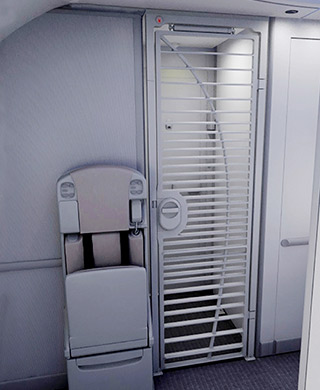Flight Deck Barriers Are Critical for Security
The 9/11 attacks exposed a major vulnerability in airline security: inadequate flight deck protection. In response, Congress mandated hardened flight deck doors on passenger aircraft to prevent unauthorized access. But these doors must still be opened during flight, creating a security risk. Security gaps remain, and passenger aircraft need secondary barriers.
The 24th Anniversary of 9/11 Approaches—FAA Must Enforce the Law and Keep Skies Safe
Further Protection Needed for Passenger Aircraft

Hardened flight deck doors improved security, but they are not a complete solution. A security device known as a "secondary barrier" is needed to prevent hostile individuals from reaching the flight deck any time the hard door is open during flight.
Secondary barriers ensure the flight deck remains secure at all times. These lightweight, retractable security gates remain deployed when the flight deck door is opened in flight, ensuring continued protection for pilots, passengers, and crew.
After years of stalling, the FAA recently finalized a rule requiring secondary barriers on newly manufactured commercial airline passenger aircraft. But this regulation does not apply to existing aircraft, leaving many planes unprotected.
In May 2024 Congress passed the FAA Reauthorization Act of 2024. Section 350 of the legislation requires the FAA to:
- Convene an aviation rulemaking committee (ARC) to review and develop findings and recommendations to require installation of a secondary cockpit barrier on commercial passenger aircraft operated under the provisions of Part 121 that are not captured under another regulation or proposed regulation.
- Not later than 12 months after the convening of the ARC, the FAA shall submit to Congress a report based on the ARC's findings and recommendations.
- Not later than 36 months after the date of the submission of the report to Congress, the FAA shall, taking into consideration the final reported findings and recommendations of the ARC, issue a final rule requiring installation of a secondary cockpit barrier on each commercial passenger aircraft operated under the provisions of Part 121.
Flight Deck Security Incidents
SEPTEMBER 11, 2001
Four commercial aircraft were hijacked by terrorists, leading to nearly 3,000 deaths. The attacks exposed the need for stronger flight deck security, resulting in a mandate for hardened flight deck doors on passenger aircraft.
ONGOING
Since September 11, 2001, at least 52 hijacking attempts have occurred worldwide. U.S. government officials continue to confirm that aviation remains a target for terrorist activity, highlighting the persistent threat of hijackings. Additionally, there has been a significant increase in unruly passenger events and events involving attempted breach of the flight deck since the pandemic.
ALPA Recommends: Strengthen Flight Deck Security
Hardened flight deck doors were a major step forward after 9/11, but they aren’t enough. Without secondary barriers on passenger aircraft flight deck security remains incomplete. We are calling on the FAA to
- Reject attempts to delay critical flight deck security measures.
- Implement, without delay, the secondary barrier requirement as Congress mandated as outlined in Section 350 of the FAA Reauthorization Act of 2024 requiring secondary barriers for all commercial passenger airline aircraft.

